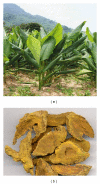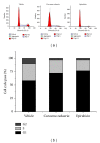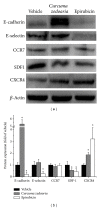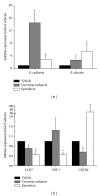Extracts from Curcuma zedoaria Inhibit Proliferation of Human Breast Cancer Cell MDA-MB-231 In Vitro
- PMID: 24883070
- PMCID: PMC4026840
- DOI: 10.1155/2014/730678
Extracts from Curcuma zedoaria Inhibit Proliferation of Human Breast Cancer Cell MDA-MB-231 In Vitro
Abstract
Objective. To evaluate the effect of petroleum ether extracts of Curcuma zedoaria on the proliferation of human triple negative breast cancer cell line MDA-MB-231. Methods. The reagents were isolated from Curcuma zedoaria by petroleum ether fraction. It was assayed by CCK8 for MDA-MB-231 cellular viability with various concentrations and days, cell cycle analyses, Western Blot analysis, and Realtime Reverse Transcriptase PCR analyses for chemokines molecules including E-cadherin, and E-selectin, and adhesion molecules including CCR7, SLC, SDF-1, and CXCR4. Epirubicin was used as control in the study. Results. MDA-MB-231 cells were inhibited by petroleum ether extracts of Curcuma zedoaria (P < 0.05), and the inhibition rate was dependent on concentrations and time. Petroleum ether extracts of Curcuma zedoaria as well as Epirubicin produce a significant G0/G1 cell cycle arrest. The level of expression of proteins E-cadherin and E-cadherin mRNA was significantly increased, while proteins SDF-1, CCR7, and CXCR4 mRNA were decreased after being incubated with petroleum ether extracts of Curcuma zedoaria at the concentrations of 300 μ g/mL than control (P < 0.05). The differences were that the protein CXCR4 mRNA expression level was higher than vehicle. Conclusions. MDA-MB-231 cells were inhibited by petroleum ether extracts of Curcuma zedoaria.
Figures






Similar articles
-
Curcuma zedoaria petroleum ether extract reverses the resistance of triple-negative breast cancer to docetaxel via pregnane X receptor.Ann Transl Med. 2021 Sep;9(17):1389. doi: 10.21037/atm-21-4199. Ann Transl Med. 2021. PMID: 34733941 Free PMC article.
-
Antimicrobial activity of Curcuma zedoaria and Curcuma malabarica tubers.J Ethnopharmacol. 2005 May 13;99(1):147-51. doi: 10.1016/j.jep.2005.02.004. J Ethnopharmacol. 2005. PMID: 15848035
-
Antimetastasis Effect of Astragalus membranaceus-Curcuma zedoaria via β-Catenin Mediated CXCR4 and EMT Signaling Pathway in HCT116.Evid Based Complement Alternat Med. 2019 May 30;2019:9692350. doi: 10.1155/2019/9692350. eCollection 2019. Evid Based Complement Alternat Med. 2019. PMID: 31275425 Free PMC article.
-
Ethnobotany, Phytochemistry and Traditional Uses of Curcuma spp. and Pharmacological Profile of Two Important Species (C. longa and C. zedoaria): A Review.Curr Pharm Des. 2019;25(8):871-935. doi: 10.2174/1381612825666190402163940. Curr Pharm Des. 2019. PMID: 30947655 Review.
-
Curcuma zedoaria Rosc. (white turmeric): a review of its chemical, pharmacological and ethnomedicinal properties.J Pharm Pharmacol. 2009 Jan;61(1):13-21. doi: 10.1211/jpp/61.01.0003. J Pharm Pharmacol. 2009. PMID: 19126292 Review.
Cited by
-
Curcuma longa extract inhibits migration by reducing MMP-9 and Rac-1 expression in highly metastatic breast cancer cells.Res Pharm Sci. 2024 Apr 1;19(2):157-166. doi: 10.4103/RPS.RPS_46_23. eCollection 2024 Apr. Res Pharm Sci. 2024. PMID: 39035580 Free PMC article.
-
In vitro evaluation of the anti‑breast cancer properties and gene expression profiles of Thai traditional formulary medicine extracts.Biomed Rep. 2023 Aug 30;19(4):70. doi: 10.3892/br.2023.1652. eCollection 2023 Oct. Biomed Rep. 2023. PMID: 37719681 Free PMC article.
-
Molecular cloning, characterization and expression analysis of Frizzled 6 in the small intestine of pigs (Sus scrofa).PLoS One. 2017 Jun 14;12(6):e0179421. doi: 10.1371/journal.pone.0179421. eCollection 2017. PLoS One. 2017. PMID: 28614361 Free PMC article.
-
Curcuma zedoaria petroleum ether extract reverses the resistance of triple-negative breast cancer to docetaxel via pregnane X receptor.Ann Transl Med. 2021 Sep;9(17):1389. doi: 10.21037/atm-21-4199. Ann Transl Med. 2021. PMID: 34733941 Free PMC article.
-
Network Pharmacology-Based Validation of Caveolin-1 as a Key Mediator of Ai Du Qing Inhibition of Drug Resistance in Breast Cancer.Front Pharmacol. 2018 Oct 2;9:1106. doi: 10.3389/fphar.2018.01106. eCollection 2018. Front Pharmacol. 2018. PMID: 30333750 Free PMC article.
References
-
- Fan C, Oh DS, Wessels L, et al. Concordance among gene-expression-based predictors for breast cancer. The New England Journal of Medicine. 2006;355(6):560–569. - PubMed
-
- Rakha EA, Reis-Filho JS, Ellis IO. Basal-like breast cancer: a critical review. Journal of Clinical Oncology. 2008;26(15):2568–2581. - PubMed
-
- Smid M, Wang Y, Zhang Y, et al. Subtypes of breast cancer show preferential site of relapse. Cancer Research. 2008;68(9):3108–3114. - PubMed
-
- Yi WJ, Lu JS, GH GH, et al. Clinicopathological features of the triple-negative tumors in Chinese breast cancer patients. Breast Cancer Research and Treatment. 2009;115(2):325–333. - PubMed
LinkOut - more resources
Full Text Sources
Other Literature Sources
Research Materials
Miscellaneous

